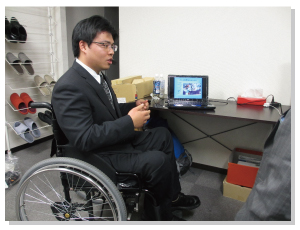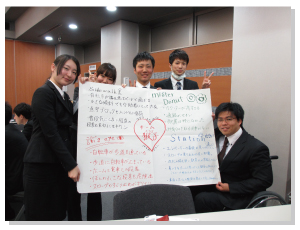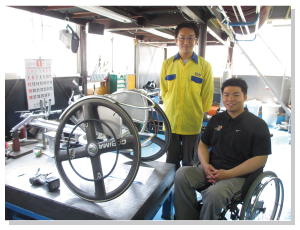- HOME
- Alumni News
- Li Bing Yu (14th trainee)
- Li's Final Report
Li's Final Report
Geeky Life’s Turning Point
1. Self-Introduction
Blanket, and tearing it up
My Name is Li Bing Yu. I am from Taichung, Taiwan. My family has 5 members, consisting of my parents, my sister, my brother in law and myself. I was born with a congenital disorder called Spina Bifida. As I grew, putting on weight and getting tall, my disability became more and more severe. During the summer holiday just before my second year at university, I had another operation, which resulted in a failure. As a consequence, I lost all functions in the lower half of my body.
For 24 years, until five years ago, I had had no knowledge about people with disabilities. I also went to a normal school. After the unsuccessful surgery during my university days, coupled with other shocking events, I began to avoid any interactions with others, especially between age 22 and 24. I never left home and spent time on nothing else but anime and games, completely segregated from the outside world. It was totally a geek’s lifestyle. The first trigger for me to leave home was my mother contacting an association for people with spinal injury. At first I joined the association’s table tennis team to get fit. In the same year, I participated in a spinal injury sport event and met Maruko-san, one of the 8th Duskin leadership program trainees who subsequently told me about the Duskin training program. It was the first change that occurred in my life. Until then I lived as if I had been in a bird cage covered with a black blanket. However, for the first time, I felt like tearing up the blanket to see the world outside the cage.

2. Coming to Japan
Cage, and walking out of it
I knew about the Duskin leadership training four years before I actually applied. But I had no courage to get out of my cage, because I did not feel capable enough to accomplish the training. I have a perfectionist nature and would not start on anything until I am sure I can do it. Thus, I decided to acquire the Japanese language first, and this held me back from applying for a few years. Finally, on September 3, 2012, I arrived in Japan. At that time I had no idea about what was awaiting me. I was just desperate to change my life. At last, I got out of my bird cage and walked off.
<1> Skiing: a wheelchair user can ski?!
Until my ski training, I had never imagined skiing. But people with physical disabilities can enjoy skiing on a bi-ski. Bi-skis tend to go faster than ordinary skis, and are more difficult to drive. For example, if you make a quick turn, you will definitely fall. The fact that bi-skis are different from ordinary ones is just like that different individuals have different abilities. As a speed maniac, I found bi-skis perfect for myself. Through skiing I understood one truth: with reasonable accommodations, people with disabilities can enjoy skiing just like those without disabilities.
<2> Home-stay
Over the New Year, I visited the Higuchi Family and Kondo Family for one week on the home-stay program. As I loved history, Mr. Higuchi looked up information and took me to the Sakamoto Ryoma Memorial Museum. I also saw the famous and mysterious ‘Passage in the Sea.’ The Higuchi Family also kindly took me to the Shimanto river, the place where my favorite TV drama had been filmed. The whole home-stay experience felt as if I had been with my real family. The overwhelmingly beautiful scenery and comfortable lifestyle calmed my mind more than anything since my arrival in Japan.
3. Training in Japan
Wall, and knocking it down
Four years passed since I got out of my cage. Nevertheless, I was still separated from the outside world by an invisible wall, I felt, and I was indeed having a problem in interacting with people. Then I came to Japan, where I started acting as the interpreter for my fellow trainees, whose language skills were limited. Subsequently I began to naturally connect with the people around me and gradually settled in the new environment. By talking to a number of people about a variety of topics, I managed to get over my past feelings of being discriminated against in society and scared of people. I thus started knocking down the invisible wall that I had created by myself, although at the beginning I was not powerful enough and could only make a crack on it. But once my individual training began, I met a number of people with a wealth of knowledge and experience, and this enabled me to come to believe that this society is not to fear of. And eventually, I have destroyed the wall completely.

4. Individual training
Self, and getting it back
In Taiwan, often I used to be told, “You cannot do this because you have a disability.” Thinking that I would not be allowed to do anything in the end anyway, I gradually lost motivation to do things, and in the end, I lost confidence in me. During my individual training, however, I met many people with disabilities far more serious than mine, listened to their personal history, and spent some time living with them. Their lives and ways of thinking taught me that there are still many things in the world that I can do. This eventually allowed me to get back the confidence to live in the society.
Wisdom, and obtaining it
<1> Center for Independent Living ‘Arc Spectrum’
My first individual training was at the Center for Independent Living ‘Arc Spectrum’. Though the training period was comparatively short, the people at the center gave me all essential knowledge necessary for independent living. I also experienced living alone in the true sense of the word. I stuck through with the three elements of independent living, “making decisions, having choices and taking responsibility.” I also participated very much in peer counseling. While I talked to others about a variety of topics, I found myself eventually finding answers for myself. It was an experience of “a person with a disability empowers himself,” the true purpose of peer counseling.
<2> Mirairo Inc.
I am a qualified barrier-free checker and used to conduct a barrier-free inspection in Taiwan. In my view, Taiwanese constructors had no understanding of the true meaning of universal design, rather than that they did not respect it at all. Therefore at the Mirairo, I received training on how to well communicate the concept of universal design to the public. You may call it a customer service technique. I also read countless documents, including construction design standards by the Ministry of Land, Infrastructure, Transport and Tourism. I also read the source document about the mapping system employed in Japanese cities, and understood why maps were not always north-oriented.
<3> Sports for people with disabilities
I love sports. In order to engage more of my friends to play sports with me, and to make others feel fitter and healthier, I attended the training program about sports. Until then I looked at sports from an athlete’s viewpoint, but through this training I learned about training with an instructor’s perspective, and I also learned about mental care for athletes. I would like to empower myself as an athlete, but also continue to build on what I have learnt to train young people.

<4> Group training
I attended many other training programs apart from the Japanese language and individual training programs. Not to mention the importance of acquiring knowledge and skills, the most important thing for me was through interactions with other people with disabilities, that I learned how the society looked from their perspectives and what kind of needs existed. If one only thinks about herself, she ends up to have a narrowed view of the world. So it is important to listen to others.
Ambition, and finding it
The Mainstream Association
The training at the Mainstream Association was different from other training programs. Of course I had lectures at the Mainstream, but at the same time, I learned so much through practical experiences about approaches to life and how to enjoy it. And this had a more striking impact on me than theoretical learning did. For example, I accompanied many of the Mainstream’s staff members to observe their daily lives. They all had a severe disability and used personal assistants in order to live independently, so it gave me an opportunity to learn how to use personal assistants as well. The members of the Mainstream were living well in their community despite the severity of their disabilities, based on the independent living movement. I started to want to introduce these initiatives to people in Taichung. This is another ambition of mine for future – in addition to my wish to perform in the Paralympics.
5. What I will do back home
Target, and hitting it
When I go back to Taiwan, the first thing I will do is to find peers with whom I can work on the independent living movement. I would also like to be Taiwan’s archer in the Paralympics, while communicating to the people around me what I have learnt in Japan about the independent living movement. I will share more detail, with those who show their interest. Moreover, I would like to establish a center for independent living in Taichung, form a network with my predecessor Duskin trainees in the Taipei Center, work with them and change Taiwan’s system for the better. I would like to see the independent living movement prevail in other parts of Taiwan.
6. Lastly
The 10-month training in Japan has become a big turning point for me. I do not yet see the whole picture of how I have changed, but my way thinking has definitely changed. For example, before I attended my individual trainings, I was only thinking about sport. But now I am also interested in the independent living movement for people with disabilities.
I would like to say thank-you to the members of the committee who selected me as one of the trainees. Had it not been for this opportunity, I would still have been a sport nerd. I am very grateful to my Japanese teachers and all other teachers at my training destinations, who shared their knowledge and experiences. I would also like to say thank-you to everyone I met in Japan. If I had not met them, I might have given up half-way. You are pillars of my heart. I would also like to express my gratitude to my fellow trainees, who helped each other and overcame so many obstacles together. Lastly, I would like to say a word of thanks to the host of this training, the Duskin AINOWA Foundation. Thanks to this training, we the trainees get a chance to change, and all the former trainees are working hard to gradually change the lives of people with disabilities in the Asia-Pacific region. Thank you very much indeed.





